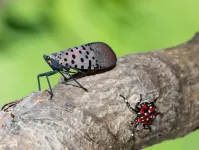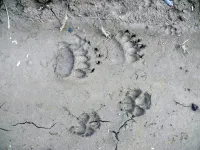The distribution of vertebrate animals redefines temperate and cold climate regions
2021-02-18
(Press-News.org) The distribution of vegetation is routinely used to classify climate regions worldwide, yet whether these regions are relevant to other organisms is unknown. Umeå researchers have established climate regions based on vertebrate species' distributions in a new study published in eLife. They found that while high-energy climate regions are similar across vertebrate and plant groups, there are large differences in temperate and cold climates.
Climate determines how life organises across the world. Understanding which climatic conditions drive important changes in ecosystems is crucial to understanding and predicting how life functions and evolves.
Human well-being critically depends on the vertebrate diversity, and yet we don't know enough about the climates that promote the organisation of these species. We know for instance that dry environments promote the generation of deserts, and humid and hot environments allow evergreen forests to thrive. But what conditions drive the distribution of vertebrates like mammals, frogs, birds and more?
"To fill this gap, we studied the climates driving the organisation of vertebrates on Earth. We developed a network-based approach that connects species to their preferred climatic conditions. Then, we searched for climatic conditions preferred by similar vertebrate species," explains main author Joaquín Calatayud former post doc at Integrated Science Lab, Umeå University, and today working at King Juan Carlos University in Spain.
With this approach, the authors presented the climate regions that define the distribution of vertebrates. Climates with high-energy, such as deserts, tropical savannas, and steppes, were found to be similar across different groups of vertebrates and plants. This was not the case for temperate and cold climates. Regions characterized by those climates differed across all groups. For instance, warm-blooded birds and mammals define regions of polar climates that are not observed in the case of cold-blooded amphibians and reptiles. This suggests that inhabiting these climates requires possessing specific climatic adaptations that have not appeared in all groups.
"Our results indicate that specific climate classifications are required to study the ecology, evolution, and conservation of specific groups of species," says Joaquín Calatayud.
This study can build the basis for a better understanding of climate-driven ecological and evolutionary processes, leading to better conservation strategies, the authors say.
"Do ecosystem functions or evolutionary processes vary among climate regions? Do climatic regions hold a similar conservation status? These are some of the questions that our results could help to answer."
INFORMATION:
Original article:
Joaquín Calatayud, Magnus Neuman, Alexis Rojas, Anton Eriksson, Martin Rosvall: Regularities in species' niches reveal the world's climate regions. eLife 2021 (10:e58397). DOI: 10.7554/eLife.58397
[Attachments] See images for this press release:

ELSE PRESS RELEASES FROM THIS DATE:
2021-02-18
Having trouble coping with COVID?
Go take a hike. Literally.
Researchers have long been aware of the positive impact of a connection with nature on psychological health and, according to a new study published in the journal Personality and Individual Differences, the pandemic hasn't decreased the power of nature to improve mental well-being.
"Thinking about the natural world in an interconnected and harmonious way corresponds to improved psychological health, no matter where you are," says Brian W. Haas, the lead author of the new study and an associate professor in the Behavioral and Brain Sciences Program at the University of Georgia.
Haas and his collaborators - Fumiko Hoeft, a professor of psychological sciences at UConn ...
2021-02-18
Almost 100 years ago, a revolutionary discovery was made in the field of physics: microscopic matter exhibits wave properties. Over the decades, more and more precise experiments have been used to measure the wave properties of electrons in particular. These experiments were mostly based on spectroscopic analysis of the hydrogen atom and they enabled verifying the accuracy of the quantum theory of the electron.
For heavy elementary particles - for example protons - and nuclides (atomic nuclei), it is difficult to measure their wave properties accurately. In principle, however, these properties can be seen everywhere. In molecules, the wave properties ...
2021-02-18
An international team of researchers has developed a framework for assessing brand reputation in real time and over time, and built a tool for implementing the framework. In a proof of concept demonstration looking at leading brands, the researchers found that changes in a given brand's stock shares reflected real-time changes in the brand's reputation.
"We've developed something we call the Brand Reputation Tracker that mines social media text on Twitter and uses 11 different measures to give us an in-depth understanding of how users feel about individual brands," says Bill Rand, co-lead author of the paper and an associate professor of marketing in North Carolina State University's Poole College of Management.
The Brand Reputation Tracker ...
2021-02-18
Evidence that a sense of our physical selves can develop even without the sense of touch has been uncovered in a new study by researchers in the UK and the United States.
The research shows that if someone loses their sense of touch and 'proprioception' - their sense of body position - as an adult, they may learn compensatory skills using visual cues and conscious thought, or reasoning, to move their bodies.
Someone who has never had a sense of touch or proprioception, however, can find faster, unconscious ways of processing visual cues to move and orient themselves.
A team at the University of Birmingham collaborated with researchers at Bournemouth University and the University of Chicago on the study, ...
2021-02-18
In the late 1980s and 1990s, researchers at ETH Zurich discovered the first indications that the amount of sunlight reaching the Earth's surface had been steadily declining since the 1950s. The phenomenon was known as "global dimming". However, a reversal in this trend became discernible in the late 1980s. The atmosphere brightened again at many locations and surface solar radiation increased.
"In previous studies, we showed that the amount of sunlight that reaches the Earth's surface is not constant over many decades but instead varies substantially - a phenomenon known as global dimming and brightening," ...
2021-02-18
Researchers from Rutgers Cancer Institute of New Jersey, the state's only National Cancer Institute-designated Comprehensive Cancer Center, evaluated the frequency of SARS-CoV-2, the virus that causes COVID-19, on various environmental surfaces in outpatient and inpatient hematology/oncology settings located within Rutgers Cancer Institute and Robert Wood Johnson University Hospital, an RWJBarnabas Health facility. The study revealed extremely low detection of SARS-CoV-2 on environmental surfaces across multiple outpatient and inpatient oncology areas, including an active COVID-19 floor. Andrew M. Evens, DO, MSc, FACP, associate director for clinical services and director of the Lymphoma Program at Rutgers Cancer Institute and medical director of the oncology service ...
2021-02-18
Annapolis, MD; February 17, 2021--When the invasive spotted lanternfly arrived in the United States in 2014, it was immediately recognized for the threat it posed to native plants and crops. A community of researchers and experts in science, agriculture, and government sprang into action to respond, improving our chances for containing the pest and curbing its potential for damage.
While the effort continues, a new collection curated by the Entomological Society of America's family of journals showcases the growing body of research that is helping us understand the spotted lanternfly's biology and how to contain it. The collection features 25 articles published ...
2021-02-18
When there is a choice, wolves in Mongolia prefer to feed on wild animals rather than grazing livestock. This is the discovery by a research team from the University of Göttingen and the Senckenberg Museum Görlitz. Previous studies had shown that the diet of wolves in inland Central Asia consists mainly of grazing livestock, which could lead to increasing conflict between nomadic livestock herders and wild predatory animals like wolves. The study has been published in the journal Mammalian Biology.
Around three million people live in Mongolia, making it the most sparsely populated country in the world. In addition, there are more than 40 million grazing animals. These animals are not just a source of food but also the ...
2021-02-18
By 2030 only EV's will be in production, meaning manufacturers are racing to create a high-energy battery that's affordable and charges efficiently, but conventional battery cathodes cannot reach the targets of 500Wh/Kg
Lithium-excess cathodes offer the ability to reach 500Wh/Kg but unlocking their full capacity means understanding how they can store charge at high voltages.
A new X-ray study lead by WMG, University of Warwick has resolved how the metals and oxygen facilitate the charge storage at high voltages.
High energy storage batteries for EVs need high capacity battery cathodes. New lithium-excess magnesium-rich cathodes are expected to replace existing nickel-rich cathodes but understanding how the magnesium and oxygen accommodate charge storage at high ...
2021-02-18
As investors set their sights on the mineral resources of the deep seabed, the International Seabed Authority (ISA) is developing regulations that will govern their future exploration and possible exploitation. A new IASS Policy Brief, published in cooperation with the Federal Environment Agency (UBA), presents three recommendations to ensure that future deep seabed mining would be to the common benefit all humankind, as required by international law.
The ecosystems of the deep ocean are complex and provide a wide range of benefits to humankind. Oceans soak up carbon dioxide and act as a natural buffer to global warming in addition to regulating the climate and serving as an important ...
LAST 30 PRESS RELEASES:
[Press-News.org] The distribution of vertebrate animals redefines temperate and cold climate regions





